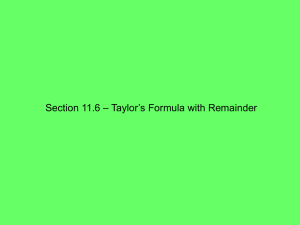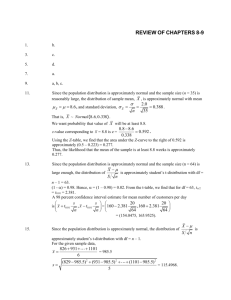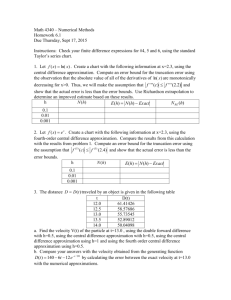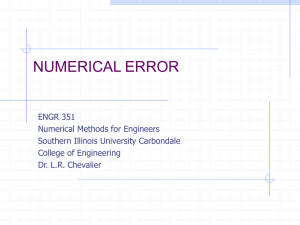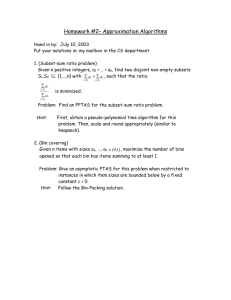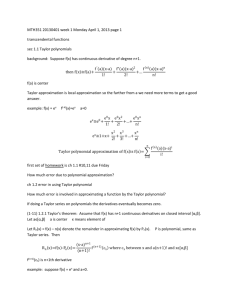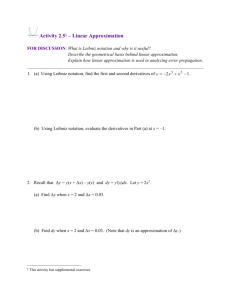1 Approximations and Errors
advertisement
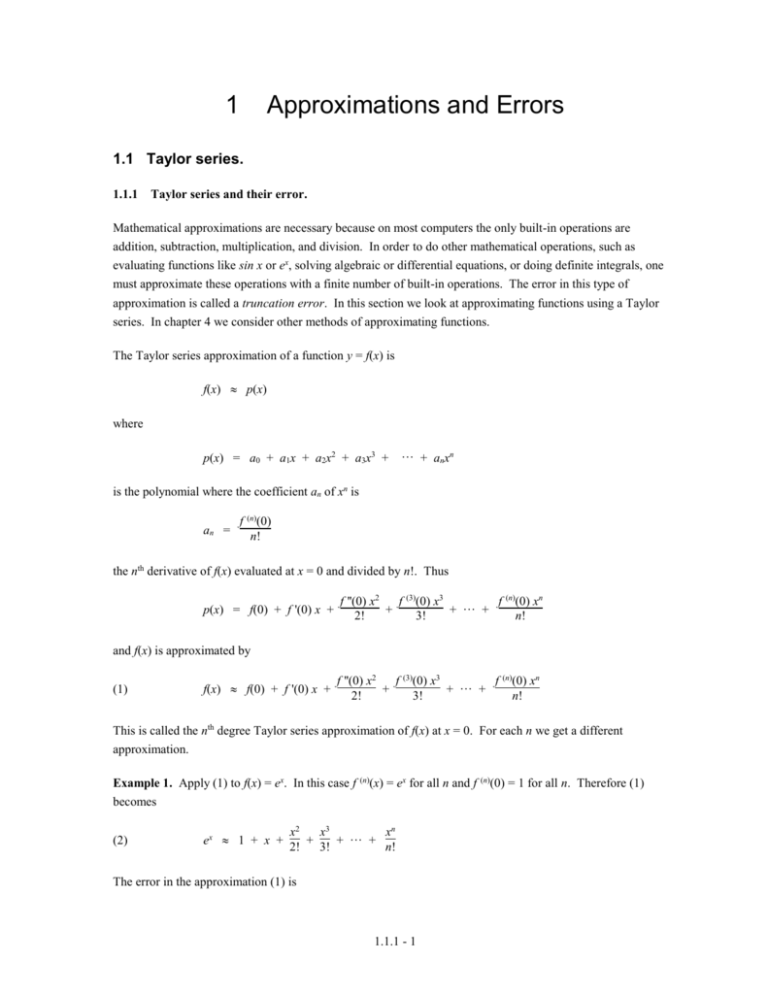
1 Approximations and Errors 1.1 Taylor series. 1.1.1 Taylor series and their error. Mathematical approximations are necessary because on most computers the only built-in operations are addition, subtraction, multiplication, and division. In order to do other mathematical operations, such as evaluating functions like sin x or ex, solving algebraic or differential equations, or doing definite integrals, one must approximate these operations with a finite number of built-in operations. The error in this type of approximation is called a truncation error. In this section we look at approximating functions using a Taylor series. In chapter 4 we consider other methods of approximating functions. The Taylor series approximation of a function y = f(x) is f(x) p(x) where p(x) = a0 + a1x + a2x2 + a3x3 + + anxn is the polynomial where the coefficient an of xn is an = f (n) (0) n! the nth derivative of f(x) evaluated at x = 0 and divided by n!. Thus p(x) = f(0) + f '(0) x + f ''(0) x2 f + 2! (3) (0) x3 f + + 3! (n) (0) xn n! and f(x) is approximated by (1) f(x) f(0) + f '(0) x + f ''(0) x2 f + 2! (3) (0) x3 f + + 3! (n) (0) xn n! This is called the nth degree Taylor series approximation of f(x) at x = 0. For each n we get a different approximation. Example 1. Apply (1) to f(x) = ex. In this case f (n) (x) = ex for all n and f becomes (2) ex 1 + x + x2 x3 xn + + + 2! 3! n! The error in the approximation (1) is 1.1.1 - 1 (n) (0) = 1 for all n. Therefore (1) (3) R = f(x) - [ f(0) + f '(0) x + f ''(0) x2 f + 2! (3) (0) x3 f + + 3! (n) (0) xn ] n! R = Rn(x) is sometimes called the remainder and it depends on x and n. It turns out that the error is approximately a constant times xn+1. Thus the error is small when x is small, but increases rapidly with x. More precisely one has the following Proposition. Proposition 1. If f(x) has n+1 continuous derivatives then x (4) f R = (n+1) (t)(x-t)n dt n! = f () xn+1 (n+1)! (n+1) 0 where is between 0 and x. The proof of Proposition 1 is given at the end of this section. Since the number in (4) is usually not known, we are usually content with an estimate of the error. Example 2. Apply Proposition 1 to f(x) = ex. In this case (3) and (4) become (5) R = ex - [ 1 + x + x2 x3 xn e xn+1 + + + ] = 2! 3! n! (n+1)! Example 3. Use (3) with n = 3 to approximate e-0.5. Then use (5) to find an upper bound for the error in this approximation. Solution. Putting x = - 0.5 and n = 3 in (3) and (5) we get 0.52 0.53 e-0.5 1 - 0.5 + = 1 - 0.5 + 0.125 - 0.0208… = 0.60416... 2! 3! e (- 0.5)4 (0.5)4 The error is R = where is between 0 and – 0.5. So 0 e 1 and 0 R = 0.0026... 4! 4! Often one wants to use (1) to approximate f(x) for x in some interval of the form - x . To find an upper bound for the error in this approximation we find K such that (6) |f for | x | . (x) | K (n+1) Then (7) | R(x) | K n+1 (n+1)! for | x | .. Example 4. If we use (3) with n = 3 to approximate ex for | x | ½, what is an upper bound for the error in this approximation? Puttin n = 3 into (3) and (5) gives (8) ex 1 + x + (9) R = x2 x3 + 2! 3! e x4 4! 1.1.1 - 2 where lies between 0 and x. Since | x | ½ one has | | ½. So | R | e1/2(½)4 = 0.00429.. for | x | ½. 4! Sometimes one wants to know how small an interval of the form | x | one must restrict x to in order that the error will be less than a given amount. Example 5. Consider the approximation (8). Let’s find so that | R | 10-4 for | x | . Arguing as in Example 4 one has | R | e4 for | x | . So we need to find so that 4e 2.4 10-3. One 4! possibility is to take as the solution of the equation 4e = 2.4 10-3. This is a nonlinear equation for that one can solve (approximately) using the methods of Chapter 2. Calculators and mathematical software have these equation solving methods built-in and if we use one of them we get = 0.210021. Another approach is to start with an upper bound for the solution of the equation, e.g. from Example 4 we see that is less than 1/2 . So e is less than e0.5 which is less than 2. We solve the equation 24 = 2.4 10-3. Its solution is = 0.18… So = 0.18 is an answer to the question, although it is not as sharp as the one obtained by solving the equation 4e = 2.4 10-3. Yet another problem is to find n so that | R | is less than a given amount for x in a given interval. Let’s suppose the interval is of the form | x | . Example 6. Consider the approximation (3). Let’s find n so that | R | is less than 10-3 in the interval | x | ½. Arguing as in Example 3 one has | R | e½(1/2)n+1 e½(1/2)n+1 for | x | ½ . So we need to find n so that 10-3. (n+1)! (n+1)! This is a nonlinear inequality for n that is hard to solve analytically. One way to obtain a solution is to make a guess at a value of n and check if it works. Based on the outcome we either increase or decrease our guess and try again. We repeat this until we find the smallest one for which the inequality holds. From Example 4 we e½(1/2)5 know that n = 3 doesn't work. If we try n = 4 then = 0.0004… < 0.001, so n = 4 works. 5! Equation (1) and Proposition 1 generalize to the nth degree Taylor series approximation of f(x) centered at x = xo. f(x) = f(xo) + f '(xo) (x - xo) + f ''(xo) (x - xo)2 f + + 2! (n) ( xo) (x - xo)n f + n! (n+1) () (x - xo)n+1 (n+1)! where is a number between xo and x This formula is in most calculus books. Section 1.9.1 has some illustrations of using mathematical software when making Taylor series approximations. Proof of Proposition 1. First consider the case n = 0 in which case (4) becomes x f(x) – f(0) = ' ' f (t) dt = f () x 0 1.1.1 - 3 The first equality is just the fundamental theorem of calculus and the equality f(x) – f(0) = f '() x follows from x the mean value theorem for derivatives. To prove the left inequality in (4) for n = 1 we integrate f '(t) dt by 0 ' '' parts letting u = f (t) and dv = dt. Then du = f (t)dt and for v we can take v = - (x-t). Therefore x x f(x) – f(0) = - f '(t)(x-t) |t = 0 + x f ''(t)(x-t) dt = f '(0)x + 0 f ''(t)(x-t) dt 0 So x f(x) – [ f(0) + f '(0)x ] = '' f (t)(x-t) dt 0 which is the left equality in (4) for n = 1. Integrating by parts again gives x f ''(0) x2 f(x) – [ f(0) + f '(0)x + ] = 2! 2 f (3)(t)(x-t) dt 2! 0 which is the left equality in (4) for n = 2. Integrating by parts n – 2 more times gives the left inequaltiy in (4) for general n. The right inequality in (4) follows from the integral mean value theorem. (See the following.) // Integral Mean Value Theorem. Suppose f(x) and g(x) are continuous for a x b and g(x) is of one sign b b between a and b. Then there is a number between a and b such that f(x)g(x) dx = f() g(x) dx. a a Problems. You may use mathematical software to help with the calculations. 1 a. Find the 8th degree Taylor series approximation to f(x) = tan x centered at xo = 0. b. Use this to estimate the value of tan(0.1). Estimate the error in this approximation. 2 c. Estimate the truncation error in part a as x varies over the interval | x | 0.2. d. For the approximation in part a, find so that | R | 10-4 for | x | . e. If in part a we take the terms up to order n, find n so that | R | 10-3 for | x | 0.2. Answers. (a) tan x x + x3/3 + 2x5/15 + 17x7/315. (b) tan(0.1) 0.100335. The error is less than 2.8 10-11. (c) 2.4 10-8. (d) 0.42. (e) 3. a. Find the 2nd degree Taylor series approximation to f(x) = x centered at xo = 1. b. Use this to estimate the value of 1.5 and find an upper bound for the truncation error. c. Find an upper bound for the truncation error in the approximation that you found in part a as x varies over the interval 1 x 1.5. d. For the approximation in part a, find so that | R | 10-4 for 1 x 1 + . e. If in part a we take the terms up to order n, find n so that | R | 10-3 for 0.8 x 1.2. 1.1.1 - 4
